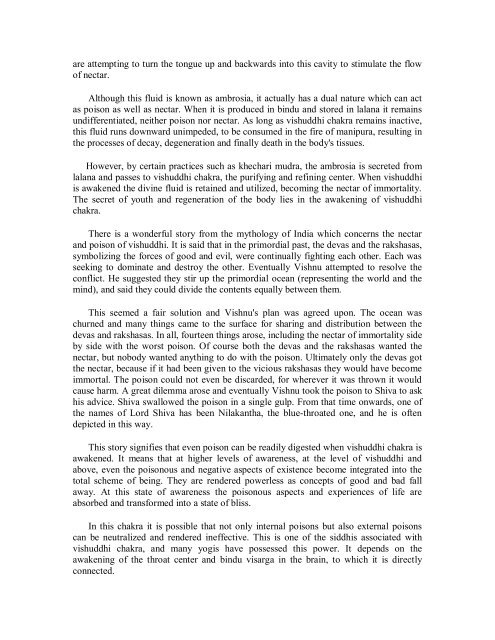Kundalini.Tantra.by.Satyananda.Saraswati
Create successful ePaper yourself
Turn your PDF publications into a flip-book with our unique Google optimized e-Paper software.
are attempting to turn the tongue up and backwards into this cavity to stimulate the flow<br />
of nectar.<br />
Although this fluid is known as ambrosia, it actually has a dual nature which can act<br />
as poison as well as nectar. When it is produced in bindu and stored in lalana it remains<br />
undifferentiated, neither poison nor nectar. As long as vishuddhi chakra remains inactive,<br />
this fluid runs downward unimpeded, to be consumed in the fire of manipura, resulting in<br />
the processes of decay, degeneration and finally death in the body's tissues.<br />
However, <strong>by</strong> certain practices such as khechari mudra, the ambrosia is secreted from<br />
lalana and passes to vishuddhi chakra, the purifying and refining center. When vishuddhi<br />
is awakened the divine fluid is retained and utilized, becoming the nectar of immortality.<br />
The secret of youth and regeneration of the body lies in the awakening of vishuddhi<br />
chakra.<br />
There is a wonderful story from the mythology of India which concerns the nectar<br />
and poison of vishuddhi. It is said that in the primordial past, the devas and the rakshasas,<br />
symbolizing the forces of good and evil, were continually fighting each other. Each was<br />
seeking to dominate and destroy the other. Eventually Vishnu attempted to resolve the<br />
conflict. He suggested they stir up the primordial ocean (representing the world and the<br />
mind), and said they could divide the contents equally between them.<br />
This seemed a fair solution and Vishnu's plan was agreed upon. The ocean was<br />
churned and many things came to the surface for sharing and distribution between the<br />
devas and rakshasas. In all, fourteen things arose, including the nectar of immortality side<br />
<strong>by</strong> side with the worst poison. Of course both the devas and the rakshasas wanted the<br />
nectar, but nobody wanted anything to do with the poison. Ultimately only the devas got<br />
the nectar, because if it had been given to the vicious rakshasas they would have become<br />
immortal. The poison could not even be discarded, for wherever it was thrown it would<br />
cause harm. A great dilemma arose and eventually Vishnu took the poison to Shiva to ask<br />
his advice. Shiva swallowed the poison in a single gulp. From that time onwards, one of<br />
the names of Lord Shiva has been Nilakantha, the blue-throated one, and he is often<br />
depicted in this way.<br />
This story signifies that even poison can be readily digested when vishuddhi chakra is<br />
awakened. It means that at higher levels of awareness, at the level of vishuddhi and<br />
above, even the poisonous and negative aspects of existence become integrated into the<br />
total scheme of being. They are rendered powerless as concepts of good and bad fall<br />
away. At this state of awareness the poisonous aspects and experiences of life are<br />
absorbed and transformed into a state of bliss.<br />
In this chakra it is possible that not only internal poisons but also external poisons<br />
can be neutralized and rendered ineffective. This is one of the siddhis associated with<br />
vishuddhi chakra, and many yogis have possessed this power. It depends on the<br />
awakening of the throat center and bindu visarga in the brain, to which it is directly<br />
connected.














![[Lonely Planet] Sri Lanka](https://img.yumpu.com/59845622/1/169x260/lonely-planet-sri-lanka.jpg?quality=85)


